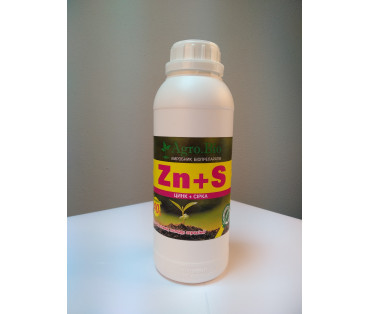Zinc (Zn) has a great influence on the redox processes in the plant organism
Zinc (Zn) acts as an important trace element, has a great influence on the redox processes in the plant organism, participates in the synthesis of the growth-promoting hormone (auxin), in the formation of ATP, chlorophyll, mineral nutrition elements, in the cell fission, in the formation of mitochondria; accelerates the flowing of protein biosynthesis (amino acid), acts as a component of 40 respiratory enzymes, increases the content of ascorbic acid, dry basis, affects the processes (nutrition, move of substances), permeability of membranes; accelerates growth and development, enhances processes of the reproductive organs (during fertilization), increases plants resistance to disease, enhances drought-, heat- and frost resistance of plants.
Zinc contributes to the absorption of copper, boron, and the reduction of elements in the soil – iron, potassium, manganese, lead, cadmium; it regulates the exchange of phosphorus. Insufficient zinc is often observed on neutral and mildly alkaline carbonated soils; its additional use on sour soils may be inappropriate.
Zinc deficiency:Insufficient zinc content in the soil is the most widespread phenomenon among agricultural plants, as a result, permeability of membranes is violated, resistance to diseases is reduced, quantitative yield indicators are reduced and crops can be lost. When zinc deficiency occurs in the spring, the buds are weakly unfolded in the fruit plants, the growth of the young leaves is slowed down, the rosette and little leaf diseases are developed, the deformation takes place on the narrow leaves (leaf asymmetry with wavy edges); the coloration is yellow and green, and also plants stunting occurs, namely the delayed crown growth, various chlorosis of leaves (small brown spots appear on the tops and leaves twist). Zinc is most required for such crops as potato, buckwheat, beets, clover, maize, rice, flax.
Abuse of zinc nutrition: produce mutations in leaf texture, the leaves at the bottom get covered with watery spots; leaves surface became hilly and in a certain time leaf abscission begins.
Zinc interinfluence with other elements
| Antagonists (overbalance of one triggers a deficiency of another element) | Synergist (improve mutual properties of each other) | Block the each other interaction (it is not recommended to combine together) |
| Mn (manganese), Fe (iron) | - | P (phosphorus), Ca (calcium) |
Related Products
Humate + Zinc + Sulfur «Agro.Bio»
The biologically available form of Zn allows you to quickly restore the balance of this important trace element in case of its insufficient amount. Zinc is part of many enzymes that are responsible fo..
$9.00

